ANESA
Science is progressing in leaps and bounds. Mathematical algorithms coupled with your body’s thermal dynamics using the principles of law of mass transfer have transformed the world of routine diagnostics into non-invasive diagnostics.
What does it mean in layman’s terms? No More Needles.
135+ parameters determining your body’s organs can be deciphered in 6 to 12 minutes. We hope to change the way the world thinks, and the 1st step towards that is is here..

A technological invention which has no analogues in the world. Dr.Malykhin A.V.,endocrinologist whose credentials are unmatched, along with Pulavaskyi deciphered this based on mathematical algorthims and thermo dynamics (Malykhin Pulavaskyi method patent no.3546A61B5).
The ANESA is knows as Noninvasive Hemogram Analyser. Known as NHA in india ( adapted to Indian tropical conditions).
AMP in China (adapted to Chinese Terrain).
Operating Principles
Based on the connect between the human body and the environment by interaction of the enzymatic hormonal system and the hemopoietic system, a method was developed on the kinematic exponential relationship between the response rate and temperature and the transformations of temperature into radiation energy.
This principles is grounded on the postulation by Galzinge and Mauzali in 1979 about the physical parameters of mediator molecules such as dipole moment, molar refraction and their exciting or retarding properties with respect to the course of biochemical reaction.

Dr. Malykhin A V and his team made the evaluations of dipole moment, by vector method with the use of inter nuclear distance of chemical, relative molor mass of substance, Xe 86 wave length and other structural data, namely linear dimensions of cardiac and somatic capillary vessels, Erythrocyte diameter, Body temperature and atmospheric pressure and gas composition of atmosphere, function of mass transfer and specific conductivity which is connected with oxygen diffusion coefficient.
The principles of ANES/AMP/NHA is based on the processing of behavior of temperature indicators in representation points that is bifurcation of carotid artery on the left and on the right, in axillaries and umbilicus and is based on the relationship between variations in oxygen diffusion coefficient.
An algorithm is associated with processing information, data is read from an input source, written to an output device, and/or stored for further processing. Stored data is regarded as part of internal state of the entity performing the algorithm.
The use of hardware and software technology enables the neuro chemical mechanism in the real time.

For Whom
A resource for efficient decision-making
ANESA allows medical professionals to easily monitor the health parameters of their patients on a regular basis. The device runs on deep learning algorithms, which allows identifying the signs of pathologies and health threats. Combination of user-friendly interface and convenient size of ANSEA adds value to the daily routine work of a medical professional, as it makes possible to carry out multifunctional screening of patients rather quickly. Perfect for health institutions, hospitals and clinics, sport/fitness and wellness centres, private practice of physicians.
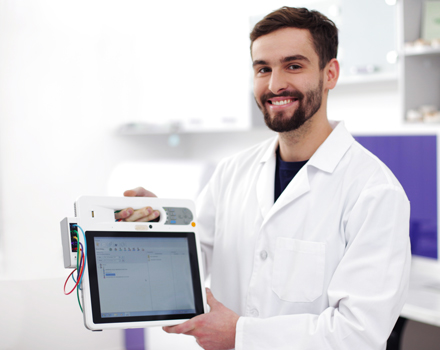
Functional
Real-time testing
Check-up of the functional state of a body at a given time.
Parameters
A total of 136 hemodynamic, biochemical and immunological parameters
Analysis in dynamics
Ability to analyze and evaluate changes in health indicators over time.
Нealth status
Includes physical and emotional health of a patient
Diagnostics
Deep learning algorithms identify risks and signs of pathologies of the cardiovascular system, GIT, urogenital system, etc.
Reporting
Personal records in DB and detailed reporting available for every patient
Data storage
Secure data storage and simple exporting process
How it Works
The analyzer technology is based on the study of the human body ability to change the activity of the autonomic nervous system ergotropic function, depending on the frequency and strength of the action of various factors of the external and internal environment, followed by substances synthesis and disassimilation.

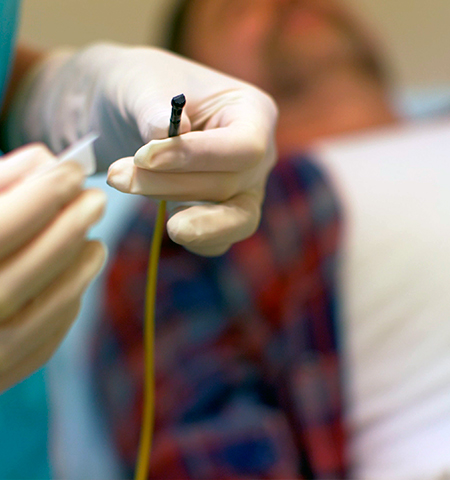
Before starting the diagnostic process, a physician creates a new patient’s card in the database software USPIH, where indicates gender, age, weight, as well as the measured heart and respiratory rates.
Microprocessors are placed on the patient’s body, and an examination interval is set. The device is now ready to start measuring

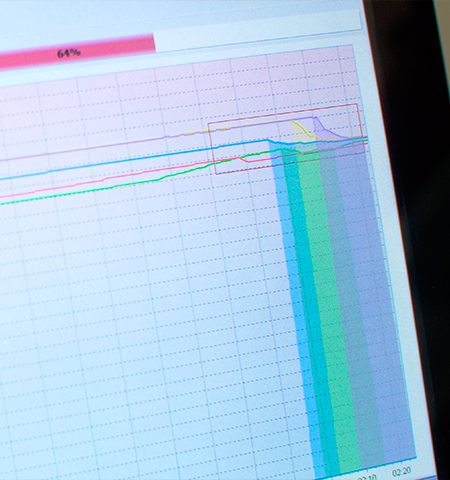
Finally, the results are ready to be saved, exported and analyzed. The entire process of non-invasive measurement takes 6 – 12 minutes.
ANESA calculates hemodynamic, biochemical and other health parameters based on the data obtained from 5 microprocessors during measurement. Information about the state of the body is analyzed by the neural network. Artificial Intelligence Learning Algorithm is software USPIH.

Manuals
User Manual
The “User’s Manual” contains information about the intended use, principle of operation, capabilities of the analyzer and software USPIH. Technical and operational characteristics, product life-time and warranties are indicated. Maintenance, transportation, storage and disposal requirements for the analyzer are included in the UM, too. The process of measurement is described, namely: preparing the analyzer for work, setting up software USPIH and working with it.
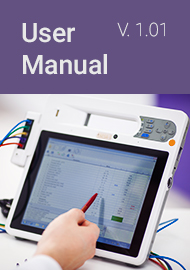
Catalogue Analyser
The catalogue contains marketing related information. Key advantages of the device, segments and applications, uniqueness, user feedback. QR codes found within the catalogue will provide additional information.

Parameters
-
+
General indicators
Erythrocytes RBC. x10¹²/l, Hemoglobin HGB. g/l, Hematocrit.HCT %, Thrombocytes. x10⁹/l, Leukocytes WBC. x10⁹/l, Lymphocytes.LYMPH %, Monocytes.MONO %, Glucose. mmol/l, Cholesterol total. mmol/l, Low-density lipoproteins (LDL). mmol/l, High-density lipoproteins (HDL). mmol/l, Triglycerides (TG). mmol/l, ALT. U/l, AST. U/l, Bilirubin, Total. μmol/l, Creatinine. μmol/l, Urea. mmol/l -
+
Hemogram
Hemoglobin HGB. g/l, Erythrocytes RBC. x10¹²/l, Leukocytes WBC. x10⁹/l, Mean cell haemoglobin (MCH). Pg, Mean cell volume (MCV). Fl, Mean cell haemoglobin concentration (MCHC). g/l, CPB (Color index of blood), Lymphocytes.LYMPH %, Segmented neutrofiles.NEUT %, Eosinophils. %, Monocytes.MONO %, Stab neutrofiles.NEUT %, Erythrocyte sedimentation rate ESR. mm/h -
+
Blood coagulation
Beginning of clotting (method of Lee-White). min, End of clotting (method of Lee-White). min, Thrombocytes. x10⁹/l, Fibrinogen. g/l, Prothrombin index (PI). %, Hematocrit.HCT % -
+
Electrolyte metabolism
Calcium (Ca). mmol/l, Magnesium (Mg). mmol/l, Potassium (K). mmol/l, Sodium (Na). mmol/l -
+
Functional parameters of stomach
pH of gastric juice, SH, Basal pressure of Oddi’s sphincter mm Hg -
+
Carbohydrate metabolism
Lactic acid. mmol/l, Glucose. mmol/l, Glycogen. mg% -
+
Hepatic panel
Aspartate transaminase (AST). mmol/l, Alanine transaminase (ALT). mmol/l, AST. U/l, ALT. U/l, De Ritis coefficient (AST/ALT), Bilirubin, Total. μmol/l, Bilirubin, Direct. μmol/l, Bilirubin, Indirect. μmol/l -
+
Protein metabolism
Protein, Total. g/l, Creatinine. μmol/l, Dopamine β-hydroxylase (DBH). nm/ml/min, Urea. mmol/l -
+
Lipid metabolism
Triglycerides (TG). mmol/l, Low-density lipoproteins (LDL). mmol/l, Very low-density lipoproteins (VLDL). mmol/l, High-density lipoproteins (HDL). mmol/l, Cholesterol total. mmol/l, β- lipoprotein. mmol/l, β- lipoprotein. g/l -
+
Water metabolism
Cellular water. %, Total water. %, Extracellular water. % -
+
Hormones
Testosterone. μmol/24hours, Estrogen, Total . nmol/24hours, Thyroxine (T4),Total. nmol/l -
+
Enzymes
Amylase (W.Т.Caraway). g/l*h, Acetylcholine. μg/ml, Acetylcholinesterase of erythrocytes. μmol/l, Tyrosine. mg*%, Creatine kinase MM (CK-MM). μmol/min/kg, Creatine kinase MB (CK-MB). μmol/min/kg -
+
Cell mitosis regulation
Comprehensive cell mitosis regulation factor -
+
Internal blood flow, in % to total blood flow
Myocardial blood flow. %, Muscular blood flow. %, Cerebral blood flow. %, Vena porte blood flow. %, Nephritic blood flow. %, Skin blood flow. %, Blood flow of other organs. % -
+
Cerebral hemodynamics
Cerebral blood flow on 100g of tissue. ml/100g, Blood flow per 1gr of thyroid gland. ml/g, Blood flow per 1gr of cerebral tissue. ml/g, Cerebral spinal fluid pressure (CSF). mm H₂O, Width of the third ventricle of cerebrum. mm Intracranial pressure (Test)(ICP), mmHg -
+
Functional parameters of cardio-respiratory system
Pulmonary vascular resistance (PVR). dyn/cm5*sec, Central venous pressure. mm H₂O, Time of pulmonary circulation. S, Time of systemic circulation. s, Energy Expenditure. kkal/kg/min, Oxygenation velocity of RBC. ml/min, Surface of gaseous exchange of RBC. m², Deficit of circulatory blood. ml/kg, Vital capacity of lungs (VC). cm³, Minute ventilation (VE) l/min, Functional residual capacity (FRC) cm³, Peak expiratory flow (PEF). l/min, Test Tiffeneau. %, Working rate of oxygen consumption. %, Time of single load. min, Respiratory exchange ratio (RER). -
+
Renal Panel
eGFR [MDRD]. ml/min/1.73m², Estimated creatinine clearance, rate(eCCr)[Cockroft and Gault]. ml/min, Cystatin C (CysC). mg/l, BUN. mg/dl, Transferrin. mg/dl, Urine specific gravity. g/cm³, Chloride. mmol/l, Ceruloplasmin (CP). g/l, Alkaline phosphatase (ALP). μkat/L
UNIQUENESS
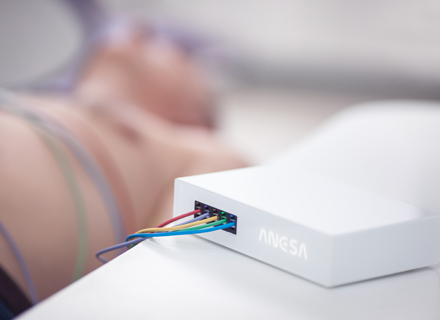
Non-invasive experience
Innovative and painless diagnostic procedure without any risks of infection, irritation or irradiation. Safe for both, the patient and the doctor. Excludes risk of infections like hepatitis C, HIV, etc.
In-depth analysis and reliability of measurements
AI and deep learning algorithms evaluate external and internal factors, remove human error and calibrate results for each individual. Multiple clinical test and external evaluations demonstrate a high level of method reliability.


Сost savings and Environmental Protection
Non-invasive technologies are considered eco-friendly, as no plastic containers or bags are needed for data collection. From a cost perspective, ANESA does not require any additional chemical reagents, special substances or consumables. Hospitals, clinics, mobile health care units, family doctors, rehabilitation and wellness centers can optimize the budgets for the primary health care and diagnosing.
Last Stories

Dr. Antoni Sicras-Mainar
The mechanisms of thermoregulation of the body, allow the mathematical algorithm ANESA to calculate a large number of indicators of human vital activity. With the help of mathematical algorithms we can check the hemodynamic, biochemical and immunological parameters of the organism. We are pleasantly surprised by the experience of using ANESA medical device. Applications of the device are effective in medical practice. The device allows you to get results in just six minutes.
FEATURES
Early diagnostics of diseases and monitoring of the treatment process. The analyzer helps to minimize the costs of the centers of medical services for the treatment, care and maintenance of patients until they are fully recovered.


High mobility. Hospitals with a deficit in diagnostic equipment and mobile hospitals can, with the help of ANESA, provide their patients with access to high-quality medical services.
Ease of screening large groups (employees, passengers, pilgrims). ANESA provides a large amount of information about the state of health (more than 130 parameters) quickly enough (3-7 minutes). Diagnostic results are known on the day of consultation and are available to Doctor immediately after testing.
.jpg)

All attention to the patient. ANESA stores a patient database in digital form, so it can significantly reduce Doctor’s time spent on recording patient data and maintaining a medical history, monitoring the health status from the last visit and / or the treatment process. Analyzer database allows you to quickly and easily carry out the necessary comparative analysis.
CERTIFICATE
DEVICE

ANESA
Innovative and painless diagnostic procedure without any risks of infection, irritation or irradiation. Safe for both, the patient and the doctor. Excludes risk of infections like hepatitis C, HIV, etc.
Software and number of available indicants
USPIH - 135
Compatible with USPIH PC Operating systems
Microsoft Windows 2000/XP/Vista/Windows 7 or higher
Compatible with USPIN PC Operating systems
Processor – Pentium 4
Ram – 512 MB HDD – 40 GB
Monitor SVGA – 1024×768
Network ports USB port – 3
Medical equipment batching

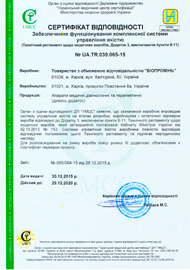
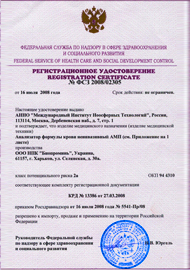
.jpg)
